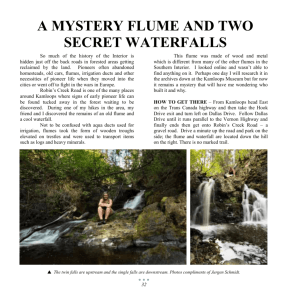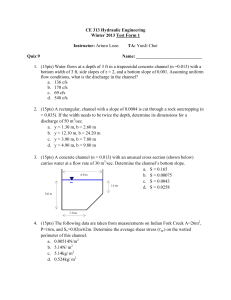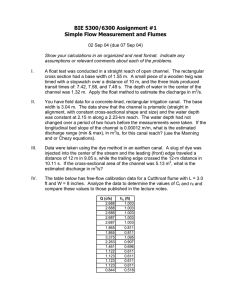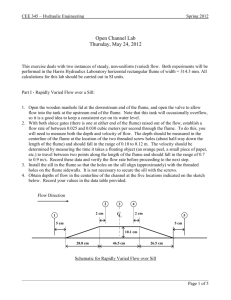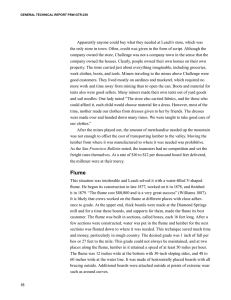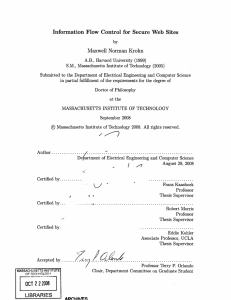BIE 5300/6300 Fall Semester 2004 Exam #1 – 19 Oct 04
advertisement
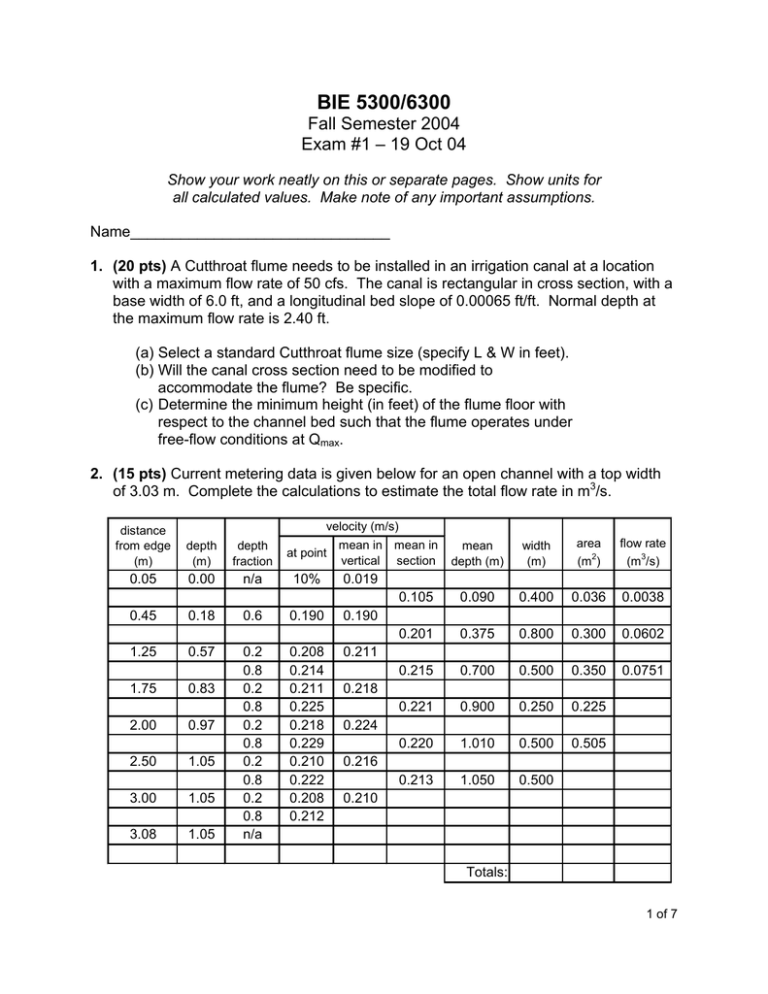
BIE 5300/6300 Fall Semester 2004 Exam #1 – 19 Oct 04 Show your work neatly on this or separate pages. Show units for all calculated values. Make note of any important assumptions. Name_______________________________ 1. (20 pts) A Cutthroat flume needs to be installed in an irrigation canal at a location with a maximum flow rate of 50 cfs. The canal is rectangular in cross section, with a base width of 6.0 ft, and a longitudinal bed slope of 0.00065 ft/ft. Normal depth at the maximum flow rate is 2.40 ft. (a) Select a standard Cutthroat flume size (specify L & W in feet). (b) Will the canal cross section need to be modified to accommodate the flume? Be specific. (c) Determine the minimum height (in feet) of the flume floor with respect to the channel bed such that the flume operates under free-flow conditions at Qmax. 2. (15 pts) Current metering data is given below for an open channel with a top width of 3.03 m. Complete the calculations to estimate the total flow rate in m3/s. velocity (m/s) distance from edge (m) depth (m) depth fraction at point 0.05 0.00 n/a 10% 0.18 0.6 0.190 0.190 1.25 0.57 0.2 0.8 0.2 0.8 0.2 0.8 0.2 0.8 0.2 0.8 n/a 0.208 0.214 0.211 0.225 0.218 0.229 0.210 0.222 0.208 0.212 0.211 0.83 2.00 0.97 2.50 1.05 3.00 1.05 3.08 1.05 width (m) area (m2) flow rate (m3/s) 0.105 0.090 0.400 0.036 0.0038 0.201 0.375 0.800 0.300 0.0602 0.215 0.700 0.500 0.350 0.0751 0.221 0.900 0.250 0.225 0.220 1.010 0.500 0.505 0.213 1.050 0.500 0.019 0.45 1.75 mean depth (m) mean in mean in vertical section 0.218 0.224 0.216 0.210 Totals: 1 of 7 3. (15 pts) You need to design a suppressed, rectangular sharp-crested weir for a rectangular channel with a base width of 2.10 m, and a Qmax of 4.5 m3/s. A normal depth of 0.678 m at Qmax was measured in the field. Manning roughness is 0.014. Design the weir, specifying crest height, P, provided the conditions are appropriate. 4. (25 pts) A BCW, operating under free-flow conditions, has a flow rate of 17.00 m3/s when hu (referenced from the sill) is 1.813 m. At this same flow rate, hd (referenced from the downstream bed elevation) is 2.661 m. The upstream and throat sections are rectangular with a width of 3.75 m. The sill height is zu = zd = 1.15 m. This BCW has a downstream ramp with a 6:1 slope. (a) Determine the upstream specific energy, Eu. (b) Determine hc (referenced from the sill) for this flow rate. (c) Estimate the hydraulic head loss in the diverging section, (hf)ds. 5. (25 pts) A circular pipe has a circular, sharp-edged orifice plate (D2 = 5.50 inches), centered in the pipe cross section, which has an inside diameter of D1 = 7.90 inches. Taps at D1 (upstream) and ½D1 (downstream) are connected to a manometer with mercury, from which a head differential of 186 mm is measured. Water temperature is 13°C. Ignoring thermal expansion adjustments: (a) Determine the ratio β. (b) Determine the kinematic viscosity, ν. (c) Determine the discharge coefficient, Cd. (d) Determine the upstream Reynolds number, Re. (e) Determine the flow rate, Q. 2 of 7 Solutions: 1. (20 pts) A Cutthroat flume needs to be installed in an irrigation canal at a location with a maximum flow rate of 50 cfs. The canal is rectangular in cross section, with a base width of 6.0 ft, and a longitudinal bed slope of 0.00065 ft/ft. Normal depth at the maximum flow rate is 2.40 ft. (a) Select a standard Cutthroat flume size (specify L & W in feet). For 50 cfs, select the W = 3 ft, L = 9 ft Cutthroat flume from the table in the lecture notes, with Qmax = 56.9 cfs. (b) Will the canal cross section need to be modified to accommodate the flume? Be specific. B = W + L/4.5 = 3 + 9/4.5 = 5 ft. Thus, no modifications to the channel section (which is 6-ft wide) except for the inclusion of headwalls (US & DS) to direct all flow through the flume. (c) Determine the minimum height (in feet) of the flume floor with respect to the channel bed such that the flume operates under free-flow conditions at Qmax. From Cutthroat flume table in lecture notes: St = 0.820, nf = 1.55, and Cf = 3.442 (ft & cfs) for the selected flume size. At 50 cfs: 1/ nf ⎛ Q ⎞ hu = ⎜ f ⎟ ⎝ Cf W ⎠ Then, 1/1.55 50.0 ⎛ ⎞ =⎜ ⎟ ⎝ (3.442)(3.0) ⎠ = 2.77 ft (hd )max = Sthu = (0.820)(2.77) = 2.27 ft Finally, the minimum floor height with respect to the channel bed is: (hfloor )min = 2.40 − 2.27 = 0.13 ft Cutthroat flume US 2.77 ft DS 2.27 ft 2.40 ft 0.13 ft 3 of 7 2. (15 pts) Current metering data is given below for an open channel with a top width of 3.03 m. Complete the calculations to estimate the total flow rate in m3/s. Note that there is a vertical wall at the 3.08 distance from the edge (otherwise, the depth would be zero at this location). The ratio x/D is: x (3.08 − 3.00) = = 0.0762 D 1.05 Then, Vx 0.65 + 10.52(0.0762) = = 0.802 VD 1 + 10.676(0.0762) − 0.51431(0.0762)2 and, Vw = 0.65(0.210) = 0.170 m/s 0.802 The rest of the calculations are simple and are given in the table below. velocity (m/s) distance from edge (m) depth (m) depth fraction at point 0.05 0.00 n/a 10% 0.019 0.45 0.18 0.6 0.190 0.190 1.25 0.57 0.2 0.8 0.2 0.8 0.2 0.8 0.2 0.8 0.2 0.8 n/a 0.208 0.214 0.211 0.225 0.218 0.229 0.210 0.222 0.208 0.212 0.211 1.75 2.00 0.83 0.97 2.50 1.05 3.00 1.05 3.08 1.05 mean depth (m) width (m) area (m2) flow rate (m3/s) 0.105 0.090 0.400 0.036 0.0038 0.201 0.375 0.800 0.300 0.0602 0.215 0.700 0.500 0.350 0.0751 0.221 0.900 0.250 0.225 0.0497 0.220 1.010 0.500 0.505 0.1110 0.213 1.050 0.500 0.525 0.1118 0.190 1.050 0.080 0.084 0.0160 mean in mean in vertical section 0.218 0.224 0.216 0.210 0.170 Totals: 3.030 2.025 0.427 4 of 7 3. (15 pts) You need to design a suppressed, rectangular sharp-crested weir for a rectangular channel with a base width of 2.10 m, and a Qmax of 4.5 m3/s. A normal depth of 0.678 m at Qmax was measured in the field. Manning roughness is 0.014. Design the weir, specifying crest height, P, provided the conditions are appropriate. Check the Froude number in this channel at Qmax. Q2 T (4.5)2 (2.10) F = = = 1.50 gA 3 (9.81) [(2.10)(0.678)]3 2 r Thus, the regime is supercritical, so it is suggested that this is not a good location for a measurement weir. 4. (25 pts) A BCW, operating under free-flow conditions, has a flow rate of 17.00 m3/s when hu (referenced from the sill) is 1.813 m. At this same flow rate, hd (referenced from the downstream bed elevation) is 2.661 m. The upstream and throat sections are rectangular with a width of 3.75 m. The sill height is zu = zd = 1.15 m. This BCW has a downstream ramp with a 6:1 slope. (a) Determine the upstream specific energy, Eu. Eu = hu + Q2 = 2gAu2 (1.813 + 1.15) + (17.0)2 2(9.81) [(1.813 + 1.15)(3.75)] 2 = 3.082 m (b) Determine hc (referenced from the sill) for this flow rate. For critical flow, the Froude number equals unity. Thus, Q2 T (17.0)2 (3.75) F = = =1 gA 3 9.81( 3.75hc )3 2 r whereby hc = 1.280 m. (c) Estimate the hydraulic head loss in the diverging section, (hf)ds. See the equations in the lecture notes: 5 of 7 log10 ⎡114.6 tan−1 (1/ 6 )⎤ − 0.165 ⎣ ⎦ ξ= = 0.638 1.742 The velocity at the critical-flow section is Vc = 17.0/((3.75)(1.280)) = 3.54 m/s. The velocity at the DS section is Vd = 17.0/((3.75)(2.661)) = 1.70 m/s. Then, (hf )ds = ξ ( Vc − Vd ) 2g 2 = 0.638 ( 3.54 − 1.70 ) 2 2(9.81) ≈ 0.11 m 5. (25 pts) A circular pipe has a circular, sharp-edged orifice plate (D2 = 5.50 inches), centered in the pipe cross section, which has an inside diameter of D1 = 7.90 inches. Taps at D1 (upstream) and ½D1 (downstream) are connected to a manometer with mercury, from which a head differential of 186 mm is measured. Water temperature is 13°C. Ignoring thermal expansion adjustments: (a) Determine the ratio β. β= D2 5.50 = = 0.696 D1 7.90 (b) Determine the kinematic viscosity, ν. ν= 1 = 1.198(10)−6 m2 /s 2 83.9192(13) + 20,707.5(13) + 551,173 (c) Determine the discharge coefficient, Cd. This requires one or two iterations. The diameter of the orifice is: D2 = 0.3048(5.50/12) = 0.140 m. The cross-sectional area of the orifice opening is: πD2 π(0.140)2 A2 = = = 0.0154 m2 4 4 Start with Cd = 0.6. Q1 = 0.6(0.0154) 2g(0.186)(13.6 − 1) 1 − (0.696)4 = 0.6(0.1194) = 0.0716 m3 /s Then, 6 of 7 Re = 4Q 4(0.0716) = = 543,500 πDν π(0.140)(0.000001198) and, Cd = 0.5959 + 0.0312(0.696)2.1 − 0.184(0.696)8 0.039(0.696)4 91.71(0.696)2.5 3 + − 0.0158(0.696) + 1 − (0.696)4 (543,500)0.75 37.06 = 0.607 + 0.75 Re = 0.609 The adjusted flow rate is: Q2 = 0.609(0.1194) = 0.0727 m3 /s Another iteration gives: Re = 551,900, and Cd = 0.609, so it is converged. (d) Determine the upstream Reynolds number, Re. Re = 551,900 (e) Determine the flow rate, Q. Q = 0.0727 m3/s 7 of 7
